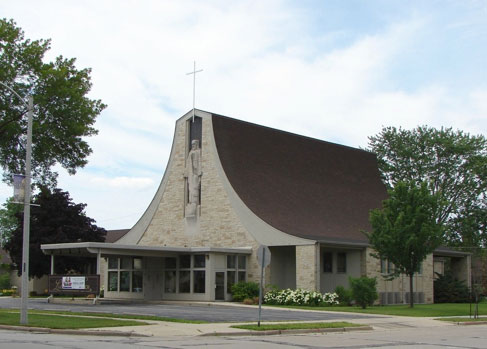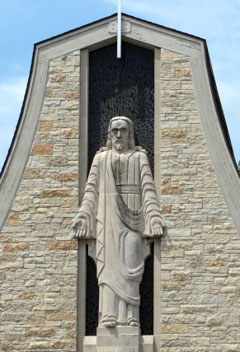65. Berea Lutheran, 1964
4873 North 107th Street (north of Hampton Avenue)
Architect: Alfred Siewert
Berea Lutheran Church was organized in 1957, in an area of northwestern Milwaukee that had been annexed to the city just a year earlier. The congregation initially built a school on the property, with the building’s small chapel serving as the place of worship for several years. Construction of the present church began in September of 1964 and was completed 13 months later.
Alfred Siewert (1899-1981), the building’s architect, was born in Wisconsin and apprenticed with architects in Milwaukee and Chicago before opening his own office in Milwaukee in the 1920s. Much of his early work consisted of small commercial and apartment buildings, but after World War II he became a prolific designer of churches as well as public and parochial schools. Siewert designed at least eight other churches in Milwaukee, mostly in the 1950s and early 1960s and mostly for Lutheran congregations. He designed another two-dozen churches elsewhere in Wisconsin and a few in Michigan’s Upper Peninsula. Like Berea Lutheran, most of his churches are distinctly modern in style.
The façade of Berea Lutheran features a 15-foot tall statue of Jesus, carved from limestone. It is the work of Adolph Roegner, a Milwaukee sculptor who had earlier collaborated with Dick Wiken to create the similar statue of Jesus on the façade of Our Savior’s Lutheran.
The most distinctive feature of the church is the concave roof, which sweeps upward to a height of about 47 feet. The roof is supported by pairs of laminated wood timbers of curved shape, with the front and rear pairs visible on the exterior. Laminated wood timbers are comprised of multiple pieces of dimensional lumber, bonded with high-strength glue to form large structural members. The technology originated in Europe, with the first patents issued in Germany in the first decade of the twentieth century. In 1934, the Unit Structures Corporation began production of glued laminated timber in the small town of Peshtigo in northern Wisconsin. The first American use of this new material was in that same year, when Unit Structures built laminated wood arches for the gymnasium of Peshtigo High School. Glued laminated timber was used primarily in Wisconsin prior to World War II. After the war, more manufacturers entered the business and the material became increasingly common nationwide for athletic facilities, auditoriums, and other buildings where long interior spans were required. Many designers of churches explored the expressive possibilities of the material, which could be fabricated in a variety of shapes to create unusual roof forms and correspondingly dramatic interior volumes, generally at a lower cost than steel or other structural materials.
On the interior of Berea Lutheran, the curved ceiling forms a tent-like canopy over the worship space, with the highest point about 42 feet above the floor. Siewert designed all of the interior furnishings, including the altar, pulpit, communion rail, pews, and baptistery.
Sources:
“Alfred H. Siewert” (obituary), Milwaukee Journal, February 9, 1981, part 2, page 4, column 7.
McNall, Andrew, and David C. Fischetti. “Glued Laminated Timber.” In Twentieth-Century Building Materials: History and Conservation, Getty Conservation Institute, 2014.
“Our History,” Berea Lutheran Church website at www.berealutheran.com.
Siewert, Alfred. Biographical file, Wisconsin Architectural Archive, Milwaukee Central Library.
Siewert, Alfred, architect. Drawings for construction of Berea Lutheran Church, dated August 4, 1964. Wisconsin Architectural Archive, Milwaukee Central Library, drawing set 127-4.

